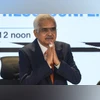Reserve Bank of India (RBI) Governor Shaktikanta Das cautioned that commentary surrounding festival season demand presents mixed signals regarding India’s economic growth. However, he said the positives significantly outweigh the negatives, and the Indian economy is doing reasonably well.
“The so-called slowdown in certain areas is outweighed by the kind of positives that we are getting. The agriculture sector is doing exceedingly well this year, thanks to a very good monsoon. The expectation for the rabi crop is very good; rural demand has now revived,” Das said in an interview with CNBC TV18 in Washington DC.
Das said several high-speed indicators were exhibiting robust growth, indicating that the economy was performing reasonably well.
He, however, highlighted that geopolitical crises, geo-economic fragmentation, and any extreme weather event that could impact external demand are the biggest risk factors to India’s economic growth.
“But by and large, India’s economic growth has always been sustained by our domestic demand and domestic investment, both of which are quite robust at the moment,” he said. The RBI has projected the Indian economy to grow at 7.2 per cent in FY25, with Q2 at 7 per cent, Q3 at 7.4 per cent, and Q4 at 7.4 per cent.
Das highlighted that growth and inflation are well balanced at the moment, which is why the policy stance was changed to neutral in the latest monetary policy meeting. “Now, we have the flexibility to watch the incoming trends, assess the evolving outlook, and decide on our policy course.”
Growth is strong, inflation has started moderating, and further moderation is expected as we approach November–December and the last quarter of FY25. However, there are significant risks to the inflation outlook, Das said, adding that any premature move could upset the balance.
More From This Section
Commenting on the possibility of a rate cut, Das said it would depend on incoming data and the inflation outlook. In fact, he said the inflation expectations of households had been moderating by 10 to 20 basis points (bps) in every round of surveys over the past two years.
Meanwhile, Das ruled out any systemic risks in the banking sector. “At the moment, the banking sector and the non-banking finance sector remain very robust at the system level.”
However, Das highlighted the issues identified by RBI in the microfinance sector. In 2022, the RBI introduced guidelines for microfinance lending, deregulating interest rates that lenders can charge in hopes of fostering competition to optimise interest rates for borrowers.
“Unfortunately, this has not happened. In our on-site and off-site supervision, we found that a number of NBFCs were charging exorbitant interest rates, going up to 40-45 per cent,” Das said, adding that the measures taken were in the best interest of customers.
Earlier this month, the RBI barred four NBFCs — Asirvad Micro Finance, Arohan Financial Services, DMI Finance, and Navi Finserv — from sanctioning and disbursing loans, citing usurious interest rates charged to their microfinance borrowers.
“Even in the cases where we have taken action, we have been in bilateral engagement with each one of them for several months. But when corrective action is not being taken to our satisfaction, we have to act and protect the interests of consumers,” Das said.
Separately, Das said the RBI had received feedback from the Indian Banks Association (IBA) and individual banks on the draft liquidity coverage ratio (LCR) guidelines. While some believe such norms should not be implemented now, others have suggested that they would need a longer implementation period.
In light of the growing number of mobile and internet banking users, the RBI has proposed tightening LCR norms by increasing the run-off factor for retail deposits. The RBI has proposed an additional 5 per cent run-off factor on both stable and less stable retail deposits with internet and mobile banking facilities.
“The discussion paper has arisen from certain potential risks that we see in today’s digital banking age, where withdrawals can happen in seconds. Our effort is to mitigate those risks, and it is being done in the interest of financial stability, but we will consider feedback from banks and other stakeholders,” Das said.

)